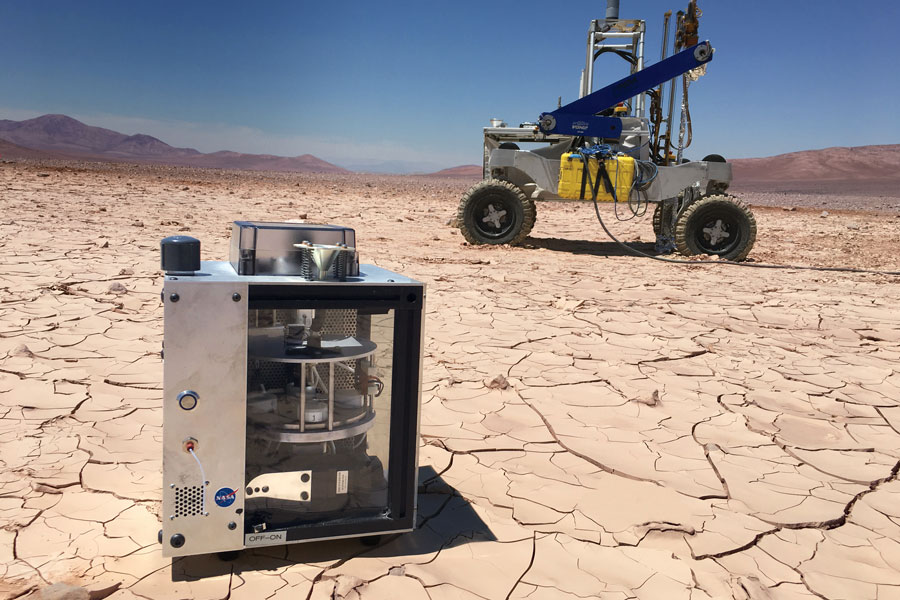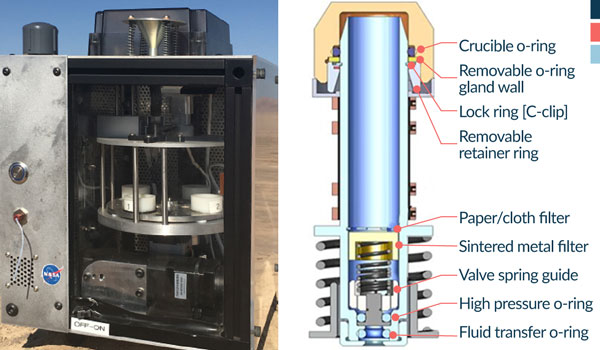Above:
Subcritical Water Extractor before installation on NASA Ames’ Research Center mobile K-Rex rover.
Organic Extraction
Taking Life Out of Dirt
Florian Kehl - Jessica Creamer - Peter Willis
It has been over 40 years since the Viking missions arrived at Mars and became the first landed missions to search for chemical signs of life on another planet. Along with its famous biology experiments, Viking was also equipped to scan for the presence of organic molecules using gas chromatography-mass spectrometry. The results of the scan showed the presence of only carbon dioxide and water, nothing that astrobiologists could use to indicate the presence of life on Mars.
However, it is possible that organic material could be locked within selected minerals on the Martian surface and Viking just did not have the instrumentation to access it. By incorporating an extraction step prior to in situ organic analysis, in addition to new surface sampling methods, it is now possible to release trace level biomarkers from the sample matrix or to liberate organics from macromolecular carbon such as proteins or even cells.
To improve the ability of in situ instruments to detect organics in a variety of low-biomass samples, we developed an automated, remotely controlled and multiplexed Subcritical Water Extractor (SCWE) system. The extraction principle is based on the ability of water to change its dielectric constant as a function of temperature and pressure. This enables efficient extraction of both polar and nonpolar, organic and inorganic compounds using a single non-toxic and environmentally benign solvent: water.
The SCWE system receives approximately 2 cm3 of the drill tailings through its vibrating inlet funnel into one of four extraction cells in the instrument’s sample carousel. First, the cell is hermetically sealed; it is then filled and precisely pressurized with water; and finally, is heated to the desired temperature, which can be set depending on the target molecules to be extracted.
Next, the extract is released from the cell and pumped into an internal collection vessel. Miniaturized electrochemical sensors measure the extract’s pH, redox potential, and conductivity, which are critical parameters for characterization of the local habitability and for understanding sample properties prior to downstream measurements. Afterward, miniaturized valves and pumps automatically portion and transfer the pre-characterized extract to a liquid analyzer such as the
Chemical Laptop.
The SCWE prototype was taken to the Atacama Desert in Chile as part of the Atacama Rover Astrobiology Drilling Studies effort, a multi NASA-center, Planetary Science and Technology through Analog Research (PSTAR) project led by Ames Research Center. In the field, the extractor unit was installed on Ames’s autonomous test rover platform KREX-2 and tested. An onboard ARM Cortex-M4 processor that reads from each sensor, controls the various actuators, and communicates with the operator’s computer performed the entire process automatically. Remote operations were performed by connecting the Ethernet port of the extractor to a TCP/IP network to send commands and display measurement data on a web server. To our knowledge, this was the first time an automated and remotely controlled subcritical water extraction, or “dirt-to-data” process has been performed in the Atacama Desert. To get further organic compositional data about the dirt, the extracts from the field were collected and returned to JPL for analysis by the
Chemical Laptop.
Subcritical Water Extractor in the Atacama Desert (left), and cross-section of a sealed extraction crucible developed together with
Ball Aerospace (right).
+ Larger image



